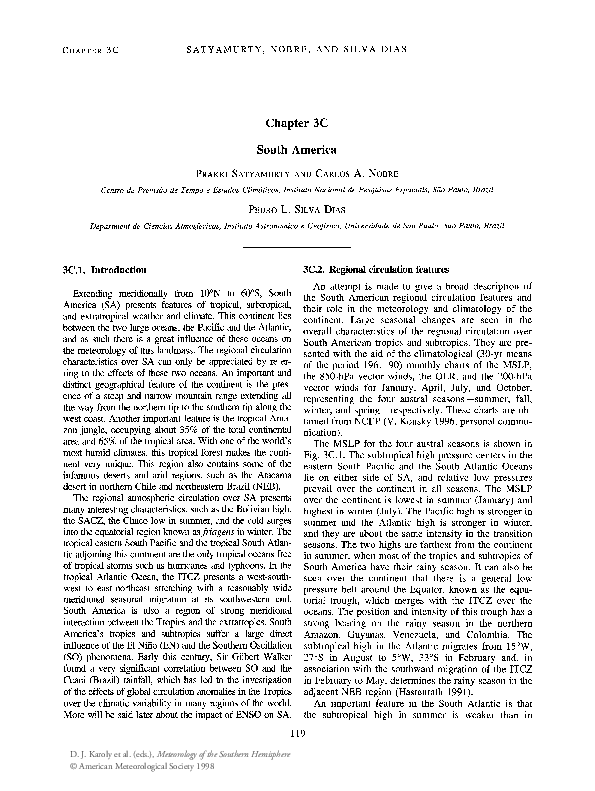Academia.edu no longer supports Internet Explorer.
To browse Academia.edu and the wider internet faster and more securely, please take a few seconds to upgrade your browser.
South America
Related Papers
Palaeogeography, Palaeoclimatology, Palaeoecology
Annual and inter-annual variability of the present climate in northern South America and southern Mesoamerica2006 •
2006 •
Climate variations have significant economic and social consequences, particularly in regions with an important world agricultural production. The study of climate variability in terms of the characterization of the atmospheric circulation and its relation with local climate is a useful tool for climate diagnostics. There are few studies where the objective identification and classification of synoptic patterns in southern South America has been performed. In the opposite, these topics have been intensely discussed in the Northern Hemisphere and other regions of the planet (Mo and Ghil, 1988; Michelangeli et al., 1995; Kidson, 2000, among others). However, as first approximations to objective synoptic classifications in southern South America Compagnucci and Vargas (1985), Compagnucci and Salles (1997) and Compagnucci et al. (1998) identified the principal spatial patterns by means of principal component analysis of observed daily sea-level pressure. Solman and Menéndez (2003) class...
2002 •
Hydrological Processes
El Ni�o-Southern Oscillation and aspects of western South American hydro-climatology2002 •
2010 •
International Journal of Climatology
Anomalies of the South American summer monsoon associated with the 1997-99 El Ni�o-southern oscillation2003 •
Journal of Climate
Climate Variability in Southern South America Associated with El Niño and La Niña Events2000 •
Atmospheric and Climate Sciences
Tropospheric Circulation Variability over Central and Southern South America2014 •
npj climate and atmospheric science
The influence of the Atlantic multidecadal oscillation on the eastern Andes low-level jet and precipitation in South America2018 •
RELATED PAPERS
Theory and Practice in Language Studies
Problems in Subtitling Cultural-Bound Expressions in “Theeb” Movie: A Case Study2021 •
In Women Photographers and Mexican Modernity Framing the Twentieth Century. Edited by Julia R. Brown, Radmila Stefkova, and Tamara R. Williams
The Untold Story of Black Mexico Uncovering the Identity of the Afro-Descendant Woman in the Photography of Koral Carballo and Mara Sánchez Renero. Routledge Research in Gender and Art, 2024, pp. 148-163.2024 •
2024 •
A Lesson to Unlearn: “The History of Interest”
A Lesson to Unlearn: "The History of Interest"2024 •
Locally Relevant ICT Research
Building Empathy for Design Thinking in e-Health: A Zimbabwean Case Study2019 •
Doctoral thesis, Institute of Education, University of London.
A common faith? : personal development, spirituality and state education1997 •
Journal of Analysis and Testing
Towards a Versatile Photoreactive Platform for Biosensing Applications2017 •
Current Developments in Nutrition
Impact of Long-chain Polyunsaturated Fatty Acids on Hyperoxia-Induced Lung Injury in Neonatal Murine Model2021 •
2013 •
2014 •
1995 •
RELATED TOPICS
- Find new research papers in:
- Physics
- Chemistry
- Biology
- Health Sciences
- Ecology
- Earth Sciences
- Cognitive Science
- Mathematics
- Computer Science

 Carlos A Nobre
Carlos A Nobre